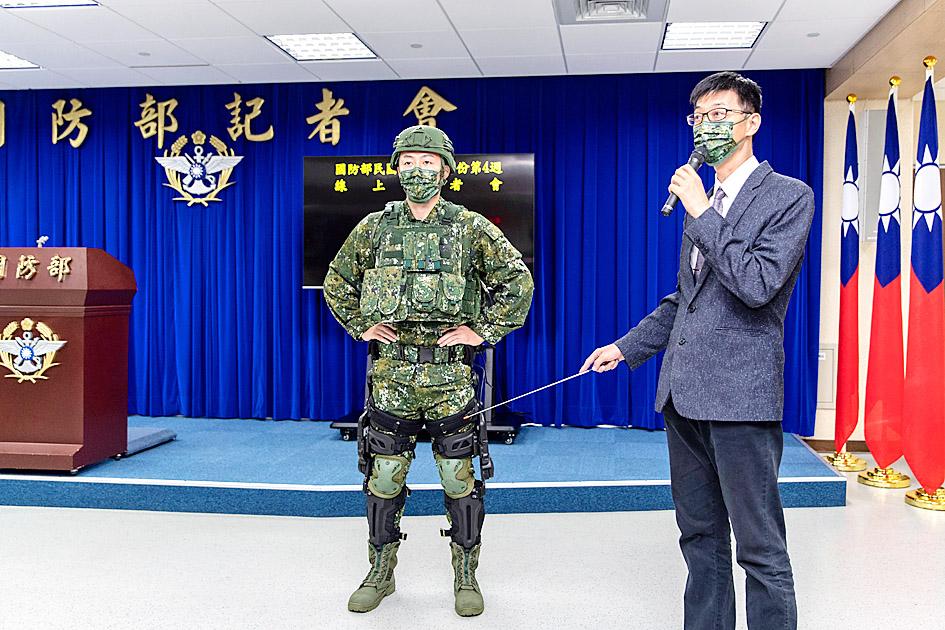The military yesterday unveiled a locally made powered exoskeleton suit, a mechanized wearable system designed to be used in wartime or during post-disaster rescue and relief missions.
The 10kg lower-body exoskeleton, which is designed to boost the strength and endurance of its users, can move at 6kph, said Jen Kuo-kuang (任國光), the project manager and a member of the military’s top research body, the National Chung-Shan Institute of Science and Technology.
The exoskeleton delivers the right torque at the right time to assist knee flexion and extension to reduce the energy needed to cross terrain, squat, or kneel for its wearers, and to increase mobility and reduce fatigue, Jen said.

Photo courtesy of the Ministry of National Defense
The exoskeleton’s lithium battery can run for six hours on a single charge, he added.
The institute has run tests on 105 soldiers to make sure the suit fits the average height and weight of Taiwanese, with minor adjustments being made based on the wearer’s body size, Jen said.
He did not provide an estimate on when the suit can be put into use by field units.
According to a budget proposal issued by the Ministry of National Defense, the military-use powered exoskeleton suit is part of a four-year NT$158 million (US$5.67 million) project running from last year to 2023.
The institute has completed the first phase of the project in designing the suit.
It will continue to modify the suit so that ultimately it can enable a user to carry a maximum load of 100kg when the four-year-project is completed, he added.
A source said the military is hoping the high-tech suits can be used during wartime and in post-disaster rescue and relief missions.
So far, only a handful of world powers, including the US, Japan, and Canada, are working on similar technology for military use, and their technology is not available at present for confidentiality reasons, which is why Taiwan needs to develop its own, the source said.
The project has learned from the US military’s experience in developing its own powered exoskeleton suit, the source said.
The military is working closely with the institute, a number of private medical technology, automation and robotic companies, and several local universities on the project, the source added.

Taiwan is to commence mass production of the Tien Kung (天弓, “Sky Bow”) III, IV and V missiles by the second quarter of this year if the legislature approves the government’s NT$1.25 trillion (US$39.78 billion) special defense budget, an official said yesterday. Commenting on condition of anonymity, a defense official with knowledge of the matter said that the advanced systems are expected to provide crucial capabilities against ballistic and cruise missiles for the proposed “T-Dome,” an advanced, multi-layered air defense network. The Tien Kung III is an air defense missile with a maximum interception altitude of 35km. The Tien Kung IV and V

The disruption of 941 flights in and out of Taiwan due to China’s large-scale military exercises was no accident, but rather the result of a “quasi-blockade” used to simulate creating the air and sea routes needed for an amphibious landing, a military expert said. The disruptions occurred on Tuesday and lasted about 10 hours as China conducted live-fire drills in the Taiwan Strait. The Civil Aviation Administration (CAA) said the exercises affected 857 international flights and 84 domestic flights, affecting more than 100,000 travelers. Su Tzu-yun (蘇紫雲), a research fellow at the government-sponsored Institute for National Defense and Security Research, said the air

Taiwan lacks effective and cost-efficient armaments to intercept rockets, making the planned “T-Dome” interception system necessary, two experts said on Tuesday. The concerns were raised after China’s military fired two waves of rockets during live-fire drills around Taiwan on Tuesday, part of two-day exercises code-named “Justice Mission 2025.” The first wave involved 17 rockets launched at 9am from Pingtan in China’s Fujian Province, according to Lieutenant General Hsieh Jih-sheng (謝日升) of the Office of the Deputy Chief of the General Staff for Intelligence at the Ministry of National Defense. Those rockets landed 70 nautical miles (129.6km) northeast of Keelung without flying over Taiwan,

A strong continental cold air mass is to bring pollutants to Taiwan from tomorrow, the Ministry of Environment said today, as it issued an “orange” air quality alert for most of the country. All of Taiwan except for Hualien and Taitung counties is to be under an “orange” air quality alert tomorrow, indicating air quality that is unhealthy for sensitive groups. In China, areas from Shandong to Shanghai have been enveloped in haze since Saturday, the ministry said in a news release. Yesterday, hourly concentrations of PM2.5 in these areas ranged from 65 to 160 micrograms per cubic meter (mg/m³), and pollutants were